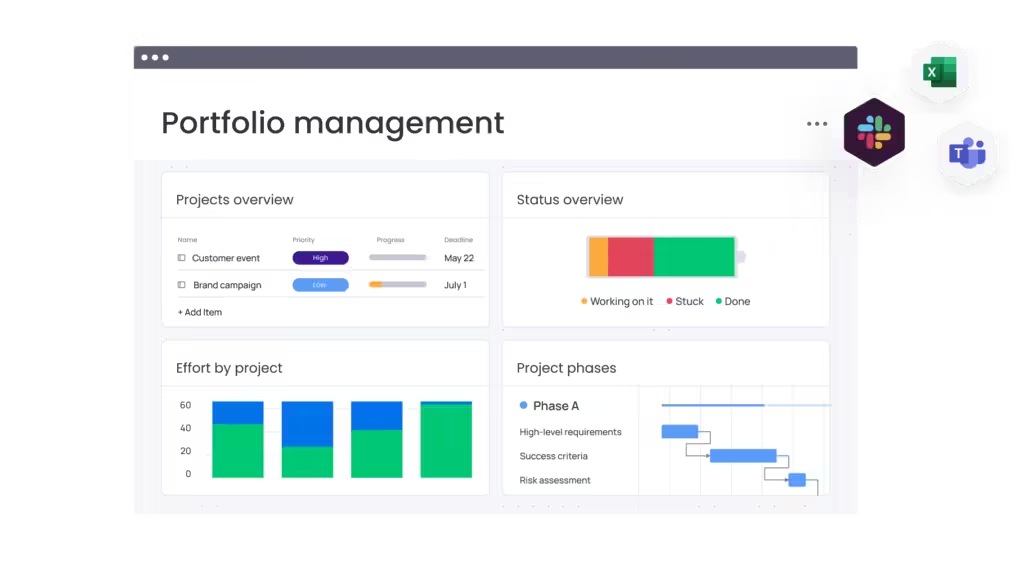What is Portfolio Management?
Portfolio management is the strategic oversight of all your projects and programs as one unified entity. Think of it as a chess game where each project is a piece on the board—every move must be strategic and contribute to your overall business success. This approach ensures that your projects aren’t just completed but actually drive value for your organization. It shifts your focus from “Are we delivering?” to “Are we delivering what matters most?”
Key Components of Portfolio Management
1. Strategic Goal Alignment
It all starts with ensuring every project supports your organizational objectives:
- Clear definition of strategic goals
- Project-to-strategy mapping
- Regular alignment reviews
- Performance tracking against objectives
2. Resource Optimization
Managing limited resources effectively is crucial for portfolio success:
- Resource inventory management
- Efficient allocation strategies
- Capacity planning
- Workload balancing
- Budget optimization
3. Risk Management
Proactive risk management across your portfolio includes:
- Risk identification and assessment
- Risk register maintenance
- Priority-based risk management
- Mitigation strategy development
- Continuous monitoring

Benefits of Portfolio Management
Implementing effective portfolio management brings numerous advantages:
Enhanced Decision Making
- Clear visibility across all projects
- Data-driven project selection
- Better prioritization
- Informed resource allocation
Resource Efficiency
- Optimized resource utilization
- Reduced bottlenecks
- Improved capacity planning
- Better budget management
Strategic Alignment
- Projects aligned with business goals
- Increased ROI
- Better stakeholder satisfaction
- Improved organizational value
Risk Control
- Proactive risk identification
- Coordinated risk response
- Reduced project failures
- Better risk mitigation
Implementing Portfolio Management
Step 1: Foundation Setting
- Define clear organizational goals
- Establish portfolio governance
- Create evaluation criteria
- Set up tracking mechanisms
Step 2: Portfolio Analysis
- Inventory current projects
- Assess resource availability
- Evaluate project alignment
- Identify dependencies
Step 3: Optimization
- Prioritize projects
- Allocate resources
- Balance the portfolio
- Establish monitoring systems
Step 4: Continuous Management
- Regular portfolio reviews
- Performance monitoring
- Resource reallocation
- Strategy adjustment
Best Practices for Portfolio Management
1. Maintain Clear Communication
- Regular stakeholder updates
- Transparent decision-making
- Consistent reporting
- Open feedback channels
2. Leverage Technology
- Use digital tools, like monday.com’s portfolio solution
- Implement tracking systems
- Automate routine tasks
- Enable real-time monitoring
3. Regular Review and Adjustment
- Schedule portfolio reviews
- Monitor performance metrics
- Adjust strategies as needed
- Document lessons learned
4. Stakeholder Engagement
- Regular stakeholder meetings
- Clear communication channels
- Expectation management
- Value demonstration
Tools for Portfolio Management
Modern portfolio management tools help streamline processes and improve visibility:
- Project tracking capabilities
- Resource management features
- Risk monitoring tools
- Performance analytics
- Stakeholder reporting
Getting Started with Portfolio Management
- Assess Current State
- Inventory existing projects
- Review available resources
- Identify current challenges
- Evaluate existing processes
- Define Framework
- Establish governance structure
- Set up evaluation criteria
- Create management processes
- Define success metrics
- Implement Systems
- Select management tools
- Train team members
- Set up monitoring
- Establish reporting
- Monitor and Adjust
- Track performance
- Gather feedback
- Make improvements
- Celebrate successes
Conclusion
Portfolio management is your key to turning project chaos into strategic success. By implementing a structured approach to managing multiple projects, you can ensure better resource utilization, strategic alignment, and ultimately, better business outcomes. Remember, effective portfolio management isn’t about managing more projects – it’s about managing projects more effectively.
If you need more help, feel free to contact our team!


